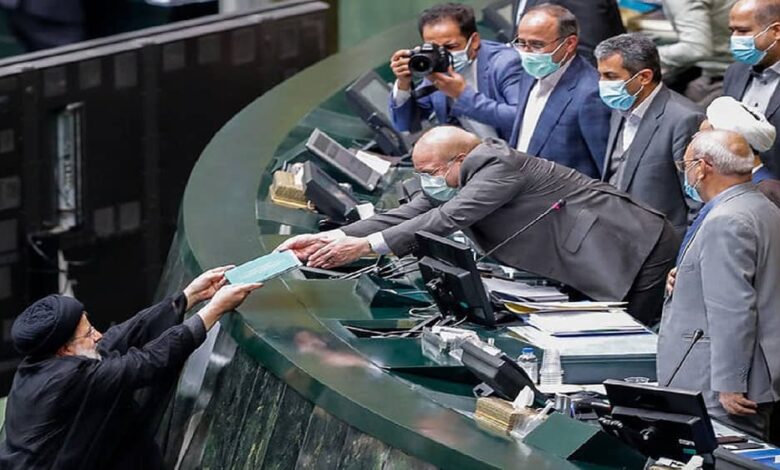In Fiscal Crisis, Iran’s Regime Escalates Oppression to Offset Budget Shortfall

iran parliament majlis raisi budget 2023 qalibaf
Written by
Mansoureh Galestan
Two-minute read
Iran’s fiscal landscape reveals a stark reality: a government grappling with a substantial revenue shortfall, leading to a dire need for budgetary adjustments. As international trade avenues remain constricted and internal financial challenges mount due to mismanagement and corruption, the Iranian regime’s strategy seems to pivot towards bolstering revenues through heightened oppression and coercion of the Iranian people.
Recent disclosures from Iran’s new year budgetary legislation highlight a remarkable surge in revenues sourced from taxation, traffic or hijab-related fines, and government bond issuances in the current fiscal year under Ebrahim Raisi’s administration. The Raisi government has bolstered tax revenues by 56%, income from fines and penalties by 111%, and earnings from government bond issuances by 87%.
This surge in revenue streams, amounting to approximately 1,600 trillion tomans, or 62% of the total general government budget, underscores the Raisi government’s heavy reliance on coercive measures to bridge the fiscal deficit. Notably, this aggressive push for revenue generation comes amidst a 3.5% decline in projected revenues from oil and gas exports, both domestically and internationally.
#Iran’s #Draft Budget for Next Year Signals Increased Pressure on the Populationhttps://t.co/ejzLRLmekg
— NCRI-FAC (@iran_policy) December 8, 2023
With dwindling oil export revenues, the clerical regime has shifted the burden of government expenditures onto citizens, exacerbating the country’s already soaring public debt. The government’s debt to the banking system, including state-owned enterprises, has surged by over 55%, reaching a staggering 1,310 trillion tomans, since the previous fiscal year.
The government’s reliance on domestic borrowing has doubled since the inception of Ebrahim Raisi’s administration. However, this domestic borrowing represents only 20% of the government’s total debt, with the majority attributed to loans from the National Development Fund, surpassing $100 billion, equivalent to 2.5 years of the government’s general budget.
Despite the substantial increase in tax revenues and projected fines and borrowing outlined in this year’s budget, the Chairman of the Parliament’s Planning and Budget Commission recently forecasted a deficit of 300 trillion tomans for the current fiscal year.
Furthermore, the Raisi government faces a dilemma: whether to finance this deficit through further bank borrowing or by issuing more government bonds, both of which carry their own set of adverse consequences.
#Iran News in Brief
The clerical regime’s Parliament Research Center has proposed a bill on #hijab, which allows the morality police patrols to enforce financial penalties on those they perceive as violating the dress code.https://t.co/qIAITfXbax pic.twitter.com/woT8JaTLMS— NCRI-FAC (@iran_policy) July 26, 2023
The Iranian regime’s previous deficits have already necessitated extensive borrowing from domestic banks, reflecting a worrying trend of financial instability. This trend has been exacerbated by the regime’s efforts to obscure its negative trade balance by underreporting imports in customs statistics.
In light of these developments, it becomes apparent that Iran’s fiscal woes are not just a consequence of economic mismanagement but rather a deliberate strategy of leveraging increased oppression and financial coercion to sustain the regime’s grip on power. As the regime continues to grapple with its budgetary crisis, the burden falls disproportionately on the shoulders of ordinary Iranians, further exacerbating society’s restiveness.
In Fiscal Crisis, Iran’s Regime Escalates Oppression to Offset Budget Shortfall

